Inglorious Basterds is Quentin Tarantino’s movie, released in 2009. Holding a revenge theme in a Nazi Germany, the scene we will look at is the final scene, called “The Final Showdown”. Nazis decide to stage the premiere of a patriotic – and therefore propaganda – movie at a French cinema, directed by Shosanna (Melanie Laurent) herself, the sole survivor of a Jewish family.
From 0:40 until the end
Analysis
The scene starts with a long shot, also called establishing shot, of the cinema where Nazi flags appear on the sides. The cinema was therefore completely redesigned following the arrival of all the Nazi community. The room is full of people, and the screen is right in the middle. The long shot lets us guess the genre of the movie: it is a war movie, a propaganda film called Nation Pride, which features the very popular German movie star (Daniel Brühl) working as a double agent, and is the personification of Nazi glory.
At some point, the hero shots an opponent straight in the eye, and the audience starts laughing and cheering, as well as Hitler, which is emphasized by a close up illustrating him as a sadistic dictator. The close up of the screen portraying the German double agent wants the audience to glorify the character. It reminds the public of the greatness of Nazi Germany, but the character also evokes the reason why the movie is being screened in Shosanna’s movie theatre: he is the link.
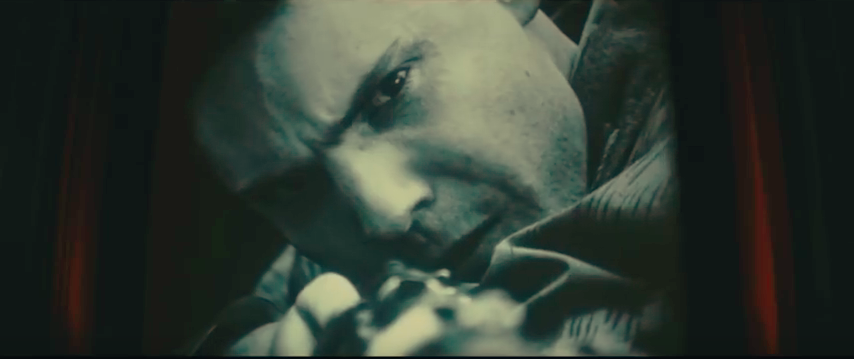
The close ups of Hitler sadistic laughing face are really the expression of Tarantino’s style: he likes the exaggeration, and here he portrays him as crazy, and laughing, while the image we all have of Hitler, is a shouting and angry guy. Here, he looks quite simple-minded.
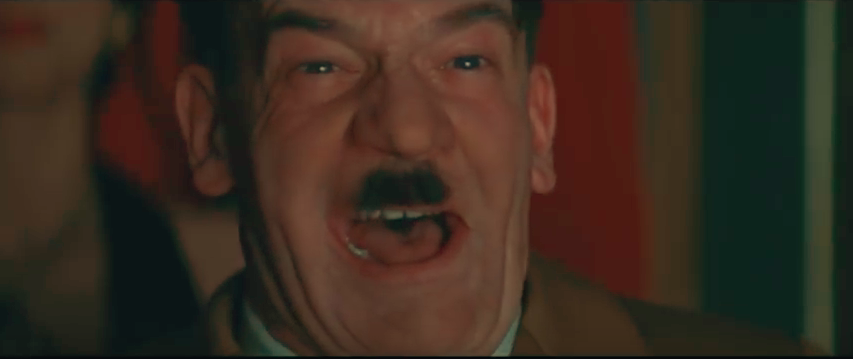
The middle shot of Hitler and the film director shows Hitler’s approval of the movie, he says: “Extraordinary my dear, simply extraordinary! This is your best film so far” in German. The film director’s reaction is quite ridiculous, which once again shows Tarantino’s humour and style. He thanks his “Fuhrer” and starts crying in the grip of emotion, the woman behind him caressing his shoulder with support highlights the ridicule trait Tarantino was wishing to represent.
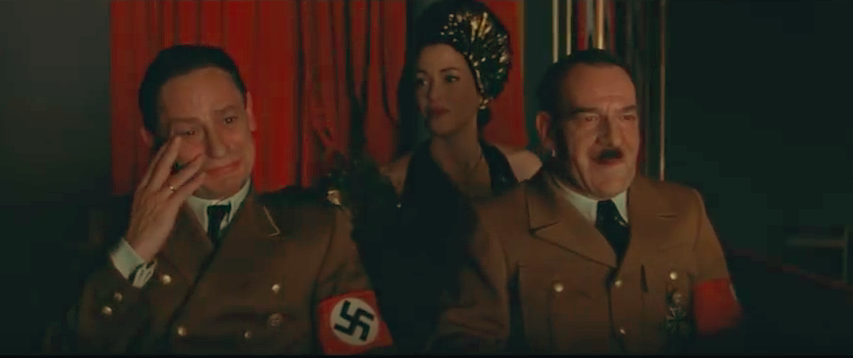
The bird’s eye view of the projection room shows the German hero and Shosanna lying on the floor, dead. She is wearing a bright red dress, which could illustrate passion of revenge, or as a nod to the Nazi flag. The background noise of the camera rolling and people cheering opposing life in the theatre and death in the projection room. Does it tell something about the fate of the audience? Will death spread over?
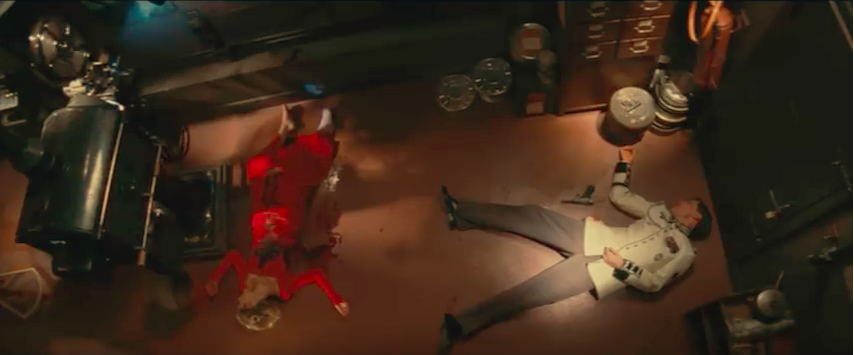
In a close up of the screen, the movie protagonist shouts “Who wants to send a message to Germany?”, which then cuts to a close up of Shosanna, with a low angle, saying calmly but with determination: “I have a message for Germany”. The fact that it is a low angle shot enables her to dominate the audience, and therefore, dominate Nazi Germany, while being dead: she is coming back from the dead in this scene.
The close up of the director of the movie having his facial expression changing to anxiety is in opposition with Shosanna’s, who in the contrary starts smiling, and shows her excitement when continuing her sentence: “That you are all going to die [pause] and I want you to look deep into the face of the Jew who’s going to do it” stressing on the word ‘Jew’, which is the initial problem.
The close up of the lips pronouncing the words “Marcel burn it down” leads to an over the shoulder shot of the back of Marcel and the lips of Shosanna in the background. This shot announces the relationship between them two, they are close but it seems like Marcel thinks highly of Shosanna. It is confirmed when he replies to his virtual friend “Oui Shosanna”, looking absolutely captivated.
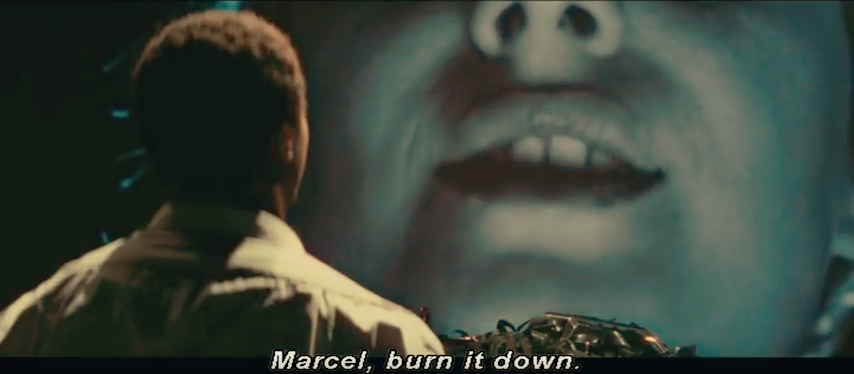
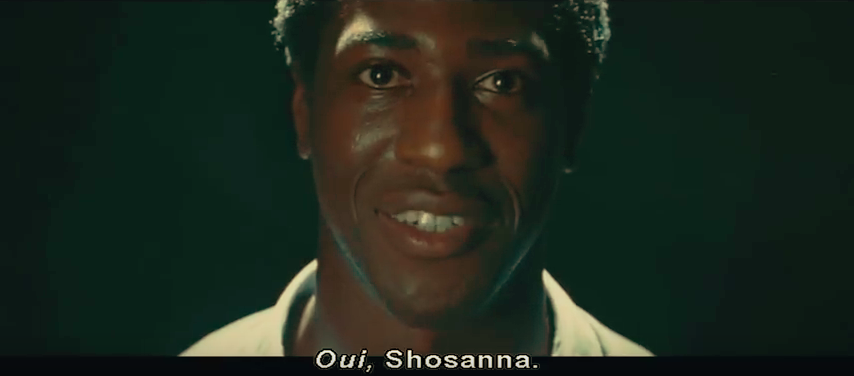
The close up of his hand throwing away a cigarette is furtive but has many consequences. A mid shot follows with a slow motion of the cigarette about to hit the tapes. The slow motion here stresses the importance of the action and announces a disruption in the – already – turbulent scene.
The fire hits the screen, where we see a hysterical Shosanna, laughing almost diabolically. It seems like it’s another character as she was always extremely calm and quiet before, but now she is the complete opposite. The explosion from the projection leads to a long shot of the whole cinema with the public running in chaos towards the exit, which is actually blocked.
We understand that everyone will burn alive, and we expect this same outcome for Hitler, however, a shot of the American Jew mechanically shooting him with a sub-machine gun tells us the opposite. Why? What’s the point? Possibly all the anger inside him made him do something that would not change Hitler’s fate, but the fact that Hitler’s face and body are completely destroyed even before burning make the audience feel like he deserved being treated that way.
The red Nazi flags are burning and illustrate the fall of Nazi Germany and Hitler; the fact that all the Nazi community and aristocracy were present in the cinema points out the political and social movement definitively collapsing.
The slow-motion shots and the explosion of colours between the fire – orange and yellow – and the blood – red – are signatures of Tarantino’s style, all in the excessiveness and the graphic violence. Between scandal and fascination, Inglorious Basterds is a perfect example of the director’s taste.
We hear Shosanna still laughing cruelly, which becomes even more disturbing once the screen is totally demolished. There is an amazing visual effect for the Nazis to witness right before their deaths and to get reminded on who destroyed them all, right before the cinema explodes spectacularly.




















